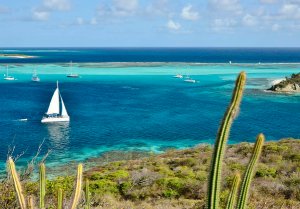Gliding through these gorgeous isles, meet green sea turtles, “boat boys” who feed and outfit you, and history in turquoise.
By: Eric Vohr, For The Inquirer
Unspoiled white-sand beaches, turquoise-blue waters, frolicking green sea turtles, and bays, lagoons, and reefs so idyllic you have to pinch yourself just to make sure they’re real – the Grenadines are one of the most spectacular sailing destinations in the world.
In this archipelago of sun-splashed Caribbean islands that stretch from Grenada to St. Vincent, there’s so much to explore that it would take a lifetime to truly appreciate it all. With only two weeks and a chartered sailboat, my photographer and I did our best to get a taste of this fabled paradise.
We rented our boat in neighboring St. Lucia; the charter company Sunsail has a large base there and we’ve had good experiences with them. We usually sail on our own, but this time we decided to join one of their “flotillas” – a number of boats following a similar itinerary. At any point in the sail, we were free to break off and go where we wanted; but we found it nice sailing with the group, especially in the evenings when we got together for drinks and dinners.
Our first day out on the water we sailed south along the protected west coast of St. Lucia to the Pitons, and then headed across the channel to St. Vincent the next day. Much less developed than St. Lucia, St. Vincent’s coastline is wild and raw; Pirates of the Caribbean was filmed here.
Just south of St. Vincent, we stopped at our first port in the Grenadines, the island of Bequia. This island has just the right mix of development (i.e., restaurants and hotels) and natural beauty. A former shipbuilding and whaling island, there’s a lot of history and a lot to explore here. Stop in the Frangipani Hotel’s seaside cafe for a coffee and a chat with the owner, Sir James Mitchell (the former prime minister of St. Vincent). He not only has some great stories, but was also one of the key players who helped establish the Tobago Cays as a protected marine park.The beauty of the Cays, our next destination, defies words. A 1,400-acre, sand-bottom lagoon surrounded by five uninhabited deserted islands and a 21/2-mile-long vibrant, colorful horseshoe reef, this is a magical kingdom where lush, green palm and sea grape trees gently sway over shimmering white-sand beaches, and playful green sea turtles greet you by sticking their heads out of the water.
There are no stores here; in fact there’s no development whatsoever, not even a shack on the beach. What they do have are “boat boys.” With creative names like “Mr. Quality,” “More Time,” and “More Fresh” these guys can provide you with fresh-baked banana bread, fish and lobster, beer and rum, shirts and shorts, and pretty much anything that’s lacking.
One of the most famous boat boys, Romeo, hosts a regular beach barbecue that’s one of the Cays’ great traditions. Our entire flotilla joined Romeo for a candlelight dinner of fresh-caught lobster and fish served on long wooden tables nestled under swaying palms.
The next couple of days in the Cays we spent exploring the turtle sanctuary off Baradal Island, where we saw many of these docile, graceful creatures feeding on sea grass on the sandy bottom. We also snorkeled the Cays’ enormous reef with its rainbow-colored corals and multitudes of neon-colored fish.
Our next anchorage, Chatham Bay, is another celebrated Grenadines destination. Unlike the Cays, which are relatively flat and dry, Chatham Bay’s cerulean waters and light-colored sand beaches are surrounded by steep mountains and green, lush jungle.
The bay has a couple of popular beach-bar restaurants; the most famous is Vanessa and Seckie’s Sun, Beach and Eat Bar. Although we dined on board that evening (I had caught a yellowfin tuna from the boat the day before), we joined Vanessa and the rest of the flotilla later for drinks and a relaxing beach bonfire.
The next day we dropped anchor at Petit St. Vincent, the farthest point south on our journey. This island is owned and operated by a private resort that has been there since the 1960s. The island has a great anchorage, wonderful beaches, and a restaurant where we enjoyed a relaxing dinner while a local steel drum band played to the gentle sound of waves lapping the shore.
After Petit St. Vincent, we headed to Saline Bay on Mayreau Island, which has a much more local feel – families barbecuing, kids playing on the beach, fishermen drinking cold Hairoun, the local beer. I spent the day exploring the island’s quaint little village, where I found a little bakery that sold me still-warm, fresh-baked baguettes.
On our way back to St. Lucia, we stopped at St. Vincent to clear customs and grabbed a mooring ball off Young Island on the southern tip of St. Vincent. We had a long sail back to St. Lucia the next day, so we decided to dine and get a good night’s rest off-boat at Young Island Resort. The resort covers the entire tiny island, and the waterfront restaurant is a favorite place for St. Vincent locals to meet and have dinner or just grab coffee and cake.
For those who sail and haven’t experienced the Grenadines yet, my advice is to book a flight and go. For those who don’t sail, find a friend who does. Either way, this is one place you don’t want to miss, it’s just that good.
Information
Sail charters
Sunsail, Rodney Bay, www.sunsail.com.
Prices vary significantly depending on the season and type of boat.
In May (off-season), a flotilla trip on a 41-foot monohull bareboat is $6,400 for 14 days.
Information
St. Lucia, www.stlucianow.com.
St. Vincent and the Grenadines, www.discoversvg.com.
Travel writer Eric Vohr and photographer Michaela Urban have an eco-travel and outdoor adventure website: www.travelintense.com.
http://www.philly.com/philly/living/travel/20141228_The_must-sail_Grenadines.html

